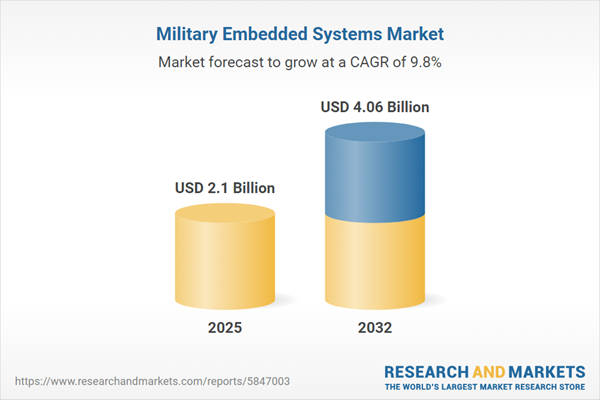Speak directly to the analyst to clarify any post sales queries you may have.
Military embedded systems are essential foundations for defense modernization, ensuring operational resilience and technological agility in complex combat environments. Senior leaders need clear, actionable market insights to guide procurement and strategy amid rapid technological transformation and shifting global dynamics.
Market Snapshot: Military Embedded Systems Market Size and Growth
The military embedded systems market grew from USD 1.91 billion in 2024 to USD 2.10 billion in 2025 and is projected to reach USD 4.06 billion by 2032, reflecting a CAGR of 9.83%. Market expansion is driven by increasing adoption of advanced computing architectures and robust security frameworks designed for mission-critical defense applications.
Scope & Segmentation of the Global Military Embedded Systems Market
This report examines key segments and technologies shaping defense embedded systems worldwide.
- Component Type: Microcontrollers, Networking Equipment, Processors, Sensors, Real-Time Operating Systems, Security Solutions
- Platform: Aircraft, Drones, Unmanned Aerial Vehicles, Armored Vehicles, Military Trucks, Submarines, Surface Combatants, Military Spacecraft, Satellites
- System Type: Closed-System Architecture, Open-System Architecture
- Application: Command & Control, Communication & Networking, Cybersecurity, Electronic Warfare, Intelligence Surveillance & Reconnaissance, Navigation & Guidance, Weapons & Fire Control Systems
- Geographic Coverage: Americas (United States, Canada, Mexico, Brazil, Argentina, Chile, Colombia, Peru), Europe (United Kingdom, Germany, France, Russia, Italy, Spain, Netherlands, Sweden, Poland, Switzerland), Middle East (United Arab Emirates, Saudi Arabia, Qatar, Turkey, Israel), Africa (South Africa, Nigeria, Egypt, Kenya), Asia-Pacific (China, India, Japan, Australia, South Korea, Indonesia, Thailand, Malaysia, Singapore, Taiwan)
- Key Companies Analyzed: Advanced Micro Devices, Advantech, AMETEK, BAE Systems, Concurrent Technologies, Curtiss-Wright, EUROTECH, General Dynamics Mission Systems, General Micro Systems, Honeywell International, Intel, Kontron Europe, Lockheed Martin, Mercury Systems, Microchip Technology, North Atlantic Industries, Northrop Grumman, Penguin Solutions, QinetiQ Group, Radisys, Raytheon Technologies, SDK Embedded Systems, Thales Group
Key Takeaways for Senior Decision-Makers
- Military embedded systems are integral to defense modernization, supporting rapid integration of next-generation sensing, processing, and secure networking capabilities across platforms operating in land, air, sea, and space domains.
- Emphasis on open architectures and modular designs enhances upgrade flexibility and lowers total lifecycle costs, facilitating third-party integrations and collaborative innovation among defense primes, technology vendors, and research institutions.
- Component and software reliability, along with real-time performance under adverse environmental stresses, remain top priorities to ensure mission assurance in high-threat environments.
- Adoption of artificial intelligence, edge computing, and advanced cybersecurity, including hardware-based security protocols, improves autonomy and decision-making efficiency at the tactical edge.
- Regional variations reflect distinct strategic priorities: the Americas advance unmanned and space capabilities; EMEA emphasizes multinational interoperability and rapid modernization; Asia-Pacific focuses on maritime awareness and cyber defense.
Tariff Impact: Navigating 2025 Tariff Policy Changes
Recent United States tariff measures have altered procurement dynamics for military embedded system components. Elevated duties on imported subsystems prompt realignment of sourcing and local manufacturing, extend lead times, and drive new collaborative trade strategies. Defense organizations are actively recalibrating supply chains, investing in domestic facilities, and forming alliances with allied nations to manage cost and production risks.
Methodology & Data Sources
This research employs layered secondary data analysis, primary expert interviews, and triangulation across industry publications, government white papers, and technical benchmarking. Regional and segment insights are validated by defense practitioners and procurement officials, ensuring accuracy and transparency.
Why This Report Matters
- Supports informed procurement and R&D prioritization by mapping technological convergence, supplier landscape, and regulatory shifts.
- Delivers actionable intelligence for risk mitigation and supply chain resilience in emerging geopolitical and trade environments.
- Aligns strategic goals with advances in open-system architectures, cyber defense, and lifecycle management for sustained advantage.
Conclusion
The military embedded systems market is defined by modular innovation, agile responses to supply chain pressures, and dynamic adaptation to global defense requirements. Leaders will benefit from a holistic analysis that embeds technology trends within operational and strategic contexts.
Additional Product Information:
- Purchase of this report includes 1 year online access with quarterly updates.
- This report can be updated on request. Please contact our Customer Experience team using the Ask a Question widget on our website.
Table of Contents
3. Executive Summary
4. Market Overview
7. Cumulative Impact of Artificial Intelligence 2025
Companies Mentioned
The companies profiled in this Military Embedded Systems market report include:- Advanced Micro Devices, Inc.
- Advantech Co., Ltd.
- AMETEK.Inc.
- BAE Systems PLC
- Concurrent Technologies PLC
- Curtiss-Wright Corporation
- EUROTECH S.p.A.
- General Dynamics Mission Systems, Inc.
- General Micro Systems, Inc.
- Honeywell International Inc.
- Intel Corporation
- Kontron Europe GmbH
- Lockheed Martin Corporation
- Mercury Systems, Inc.
- Microchip Technology Inc.
- North Atlantic Industries, Inc.
- Northrop Grumman
- Penguin Solutions, Inc.
- QinetiQ Group
- Radisys Corporation
- Raytheon Technologies Corporation
- SDK Embedded Systems Ltd.
- Thales Group
Table Information
| Report Attribute | Details |
|---|---|
| No. of Pages | 194 |
| Published | November 2025 |
| Forecast Period | 2025 - 2032 |
| Estimated Market Value ( USD | $ 2.1 Billion |
| Forecasted Market Value ( USD | $ 4.06 Billion |
| Compound Annual Growth Rate | 9.8% |
| Regions Covered | Global |
| No. of Companies Mentioned | 24 |









